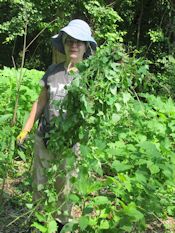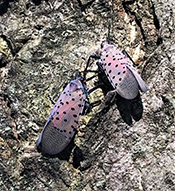How to Volunteer and Help
Share Your Talents |
Current Opportunities to Help |
|||||
|
The Friends of Dyke Marsh welcome the help of everyone, efforts big and small. We hope you will help us preserve and restore the Dyke Marsh Wildlife Preserve. Everyone’s efforts make a difference. If you wish to participate, please send an email to This email address is being protected from spambots. You need JavaScript enabled to view it. and indicate how you would like to help. We will put you on a list for the activities you volunteer for and send you an email as opportunities arise. We need help in the following areas, but feel free to indicate other ways you would like to contribute:
|
Help Tackle Invasive Plants Join FODMers from 9 a.m. to 11 a.m. on:
Nancy Herrman is a dedicated invasive plant volunteer. Help protect native plants by pulling and clipping invasive plants. We will train volunteers to identify the five or so target plants. We kindly ask that you not bring pets. Invasive plants can threaten and outcompete native plants. Bring gloves, hand clippers and water. We will supply instructions, examples and trash bags Wear long sleeves and pants and sun protection. We will have some tools to share. We will cancel if lightning or severe storms are anticipated. Meet at the Haul Road trail entrance bench. For sessions beginning at 10 a.m., if it is raining at or after 9 a.m. on the day of the session, the session will be cancelled. Haul Road Trail directions and parking: GPS coordinates: 38.777739, -77.050540 South of Alexandria off the GW Memorial Parkway at the sign for Dyke Marsh Nature Preserve and Belle Haven Marina, turn east onto the road toward the Potomac River. Take the first left and park in the Belle Haven Park lot. Walk back to the marina road and turn east, toward the river. Walk 30 yards. On your right is a Dyke Marsh sign and the entrance to the Haul Road trail. |
Spotted Lanternfly Alert
The National Park Service (NPS) asks that everyone be on the lookout for an invasive insect called the spotted lanternfly (Lycorma delicatula). As of February 3, 2023, there have been no reports of these insects on the GW Memorial Parkway properties, but the insect has been documented in Fairfax County. Please be on the lookout for their egg masses on trees and other smooth surfaces (including rocks and vehicles) from now through spring. Egg masses look like smears of mud or mortar. NPS asks that if you see one, try to scrape it off and put it into a baggie with some rubbing alcohol or hand sanitizer. The insect can be very destructive to trees. There is more information in an article by a NPS official here. For information in another article by the US Department of Agriculture click here. |
Help Stop the Spread of a New Species of Water Chestnut Water chestnut. Photo from MISC, Maryland Invasive Species Council Be on the lookout for a new species of water chestnut (genus Trapa) (http://mdinvasives.org / iotm/june-2018/) found in the Potomac watershed, Trapa bispinosa Roxb. var. iinumai Nakano. It has been spreading since 1995 and is floating aquatic vegetation growing over the surface of a pond, lake or other fresh waterbody. This species is identified by the seed cases having two spines instead of four found on Trapa natans. Report all invasive aquatic species to the US Geological Survey’s Nonindigenous aquatic species website (https://nas.er.usgs.gov / SightingReport.aspx). Water chestnut (an annual) sprouts in May, spreads over the water surface and then flowers and fruits by July. It drops seeds all season until it senesces after a hard frost. To stop the spread, management by harvesting the plants by early July is very successful in eradicating the plants, but it may take several years of effort, if some seeds fall before the plants are harvested or lay dormant in the current year and sprout in a later year. |
|||




 Friends of Dyke Marsh, Inc. is a non-profit 501(c)(3) organization.
Friends of Dyke Marsh, Inc. is a non-profit 501(c)(3) organization.